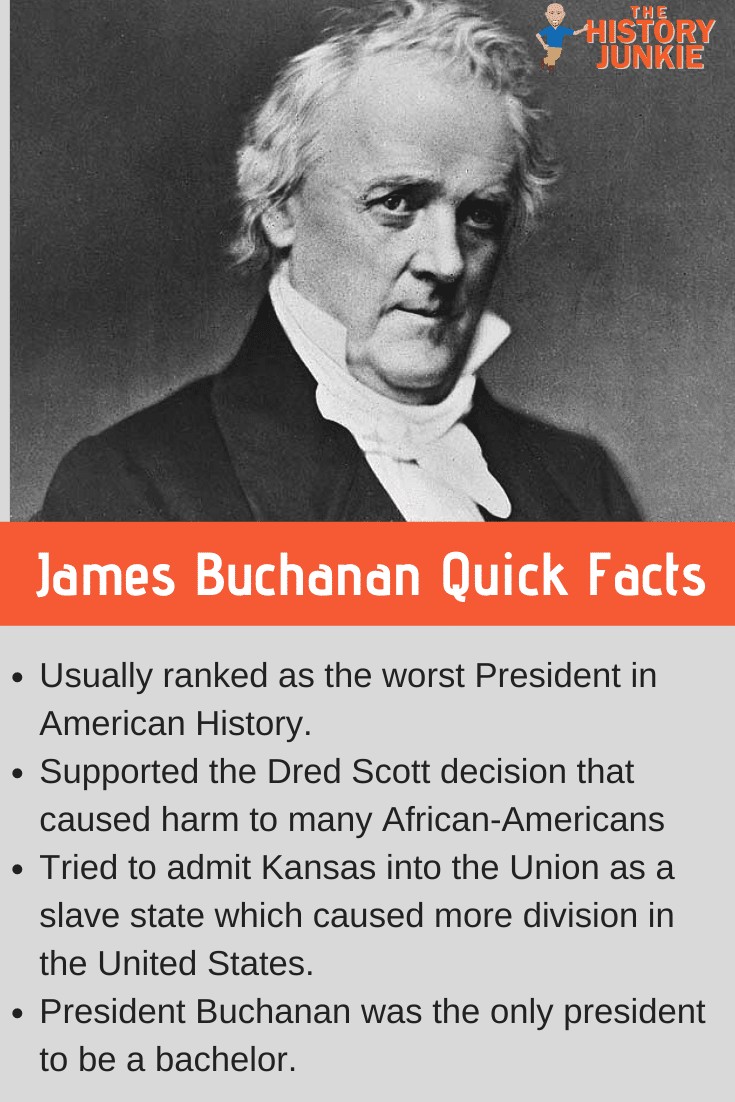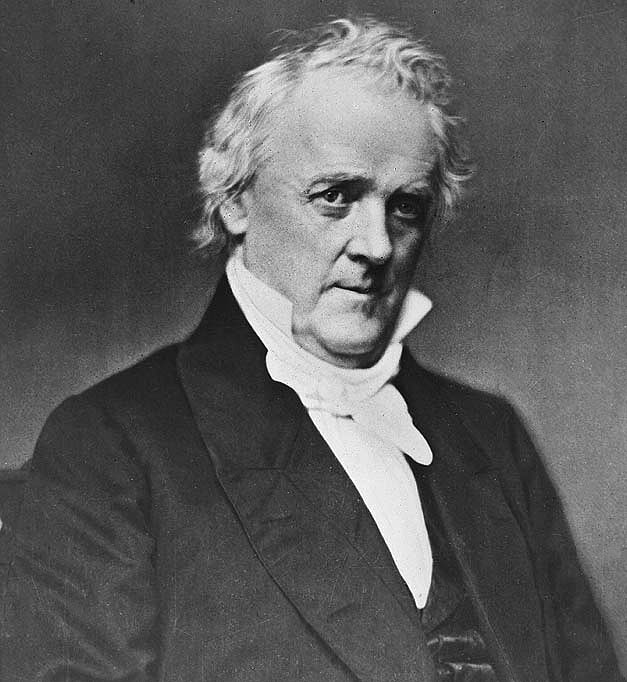President James Buchanan was the 15th President of the United States of America and is ranked as the worst President in American History. As a president, Buchanan was well-meaning but indecisive.

His lack of leadership and indecisiveness concerning slavery caused more harm than good.
Although he did not have any interest in maintaining slavery, he, like Millard Fillmore and Franklin Pierce, believed it to be best to yield to pro-slavery in order to avoid civil war.
Jump to:
His actions during his presidency only furthered the division between North and South.
President James Buchanan: 1857 - 1861

March 4, 1857: James Buchanan Inaugurated
March 6, 1857: Dred Scott Decision: James Buchanan's presidency never had much of a chance, as it began with the Dred Scott decision that ignited abolitionists and pushed the nation closer to civil war. The Dred Scott decision said that African Americans were not citizens and did not have the right to sue. The Court also stated that the Constitution does not permit the federal government to ban slavery in the territories, thereby nullifying the Missouri Compromise of 1820.
September 7 - 11, 1857: Mountain Meadows Massacre: When Buchanan ordered that Mormon leader Brigham Young be replaced as territorial governor of Utah, the Mormon militia, aided by a group of Native Americans from the Paiute Nation, attacked and killed 140 unarmed non-Mormon emigres who are passing through Utah to California.
October 5, 1857: Kansas elects an Anti-Slavery legislature
December 21, 1857: Lecompton Constitution: Kansas began voting on the Lecompton Constitution that had been drafted by an illegal pro-slavery legislature. Buchanan urged Congress to admit Kansas as a slave state despite Kansas itself wanting to be a free state.
March 23, 1858: Kansas Admitted to Union: Kansas is admitted as a slave state despite the people of Kansas wanting to be a free state. The House of Representatives asks Kansas to vote again on the state constitution.
May 4, 1858: Kansas Compromise: Congress agrees to ask Kansans to vote once more on the pro-slavery Lecompton Constitution. In a concession to pro-slavery representatives, Congress also promised to grant land to Kansas voters if they ratify the pro-slavery constitution.
May 11, 1858: Minnesota was admitted as a Free State.
July 29, 1858: Treaty with Japan Completed: The treaty opens U.S. trade rights in Japanese ports and allows American citizens to permanently reside in ports and towns. Americans also have the right to lease ground, purchase buildings, and erect dwellings and warehouses.
August 2, 1858: Kansas Rejects Lecompton Constitution: Overwhelmingly, the citizens of Kansas voted down the Lecompton Constitution from 11,300 to 1,788. Kansas was then admitted to the Union as a Free State.
August 21 - October 15, 1858: Lincoln and Douglas Debates: The infamous Lincoln - Douglas Debates take place in lieu of the Illinois Senate race. Although Douglas won the election, Lincoln gains national recognition for his arguments against slavery.
February 14, 1859: Oregon admitted as a Free State
March 12, 1859: Southern Commercial Convention: Southern slave owners argue in favor of opening the African slave trade. The trade was banned by Congress in 1808.
June 11, 1859: Comstock Lode: Silver is discovered in Nevada.
July 5, 1859: Slavery Debated In Kansas: Another constitutional convention was held in Kansas to decide whether or not to admit the state as a free or slave state. Delegates draft a constitution that not only prohibits slavery but also promotes women's rights regarding child custody, married women's property rights, and quality of public education.
October 4, 1859: The Kansas Constitution is ratified.
October 16, 1859: Harper's Ferry: John Brown raids Harper's Ferry as the first step in a plan to establish an abolitionist republic in the Appalachians. Brown is caught and hanged for murder, conspiracy, and treason against the state of Virginia. He becomes a martyr to the North.
February 27, 1860: Lincoln begins to Campaign for President. Abraham Lincoln outlines the political position of a new political party, the Republican Party.
April 23, 1860: Democrats fail to nominate anyone for President. Stephen Douglas was abandoned as a presidential nominee due to his position on "popular sovereignty"
May 9, 1860: Constitutional Union Party nominated John Bell for President
May 18, 1860: Abraham Lincoln was officially nominated as the Republican candidate for president.
June 18, 1860: Stephen Douglas received the Northern Democrat nomination for president.
June 28, 1860: John C. Breckenridge received the Southern Democrat nomination for president.
November 6, 1860: Abraham Lincoln wins the election.
December 3, 1860: James Buchanan argues that the South does not have any legal right to secede from the Union.
December 18, 1860: Senator John Crittenden of Kentucky proposes an extension of the Missouri Compromise west to the Pacific Ocean. James Buchanan supports it, but President-elect Lincoln makes it clear that he will not allow the expansion of slavery. It was called the Crittenden Compromise.
December 20, 1860: South Carolina secedes from the Union.
January 8, 1861: In his final speech, Buchanan speaks of the Union as a "sacred trust" but fails to give any recommended action to preserve the Union.
March 4, 1861: Buchanan Escorts President-elect Abraham Lincoln to Inaugural Ceremonies.
President James Buchanan: Conclusion
President James Buchanan did not stand a chance. He struggled throughout his term to control situations that he did not begin and was ignorant of when he arrived at the White House.
Dred Scott and the problems in Kansas did not begin in his presidency, but his indecisiveness and inability to lead during a crisis only caused the situation to become more toxic.
The different factions became more upset, and eventually, the Civil War was inevitable.
The best thing that occurred during his presidency was probably the opening of Japan to trade with the United States.
However, that began under President Millard Fillmore. In the end, Buchanan contributed nothing and tended to side on the wrong side of the argument.
President James Buchanan: Online Resources
- Wikipedia - James Buchanan
- White House - James Buchanan Biography
- Miller Center - James Buchanan
- James Buchanan Treason
- James Buchanan Home
- Find a Grave - James Buchanan
- A Companion to the Antebellum Presidents, 1837 – 1861 (Wiley Blackwell Companions to American History)
- The History Junkie's Guide to The United States Presidents
